Ice- and cryogel-soil composites in water-retaining elements in embankment dams constructed in cold regions
N. K. Vasiliev , A. A. Ivanov, I. N. Shatalina, V. V. Sokurov
The B. E. Vedeneev All-Russia Research Institute of Hydraulic Engineering (VNIIG Inc.), St. Petersburg, Russia
1 Introduction
The least expensive material for building water-retaining elements is clay, but only if it can be found not far away from the construction site. If that is not the case, other more expensive kinds of materials must be used, such as concrete or asphalt concrete. In cold regions, this situation is much more difficult because of transportation and technological problems.
The frozen type of embankment dams in cold regions seems to be less costly but numerous accidents and failures have eliminated this advantage. Cracks in and thawing processes connected with failure of freezing columns lead to expensive repairs. In dams of the thawed soil type, which are more expensive, erosion problems at the bottom and the sides of water-retaining elements require further expenditures to build transition layers. Also, earthquake events can damage dams of both types, especially the upper parts of water-retaining elements. All these problems can be solved with the use of comparatively inexpensive ice- and cryogel-soil composites, which have the necessary permeable, plastic,thermophysical, and strength properties in both frozen and thawed conditions.
In recent years a great deal of attention has been focused on the study of cryogels obtained by cryotropic gel formation(CGF) (Lozinsky, 2002; Altuninaet al., 2006; Vasilievet al.,2012). Cryogels are considered as potential materials for solving practical problems, especially cryogels with a polyvinyl alcohol (PVA) base. The range of application for cryogels is increasing (Lozinsky, 2002), including the development of reliable materials for building dams and other hydro engineered constructions. Material created by the CGF method has low permeability and can be used in a wide range of temperatures above and below 0 °C. An example of such an application is the experimental full-scale moisture-proof coating developed for the bottom of the ash disposal of a heat and power plant in Magadan in the eastern region of Russia (Report, 1992).
In the CGF method, strong hydrogels are formed from an aqueous polymer solution such as PVA; other hydrogels are formed by means of a freezing and thawing process in which PVA solutions are frozen at -5 to -20 °C and are then allowed to thaw to a positive temperature. PVA is a polymer with exceptional properties such as water solubility, biocompatibility,non-toxicity, and non-carcinogenicity, and it has the capacity to form hydrogels by chemical or physical methods. PVA is a reasonably priced and versatile polymer, adaptable to various needs with minor modifications for synthetic procedures. PVA has been applied in railway construction on the Zabaikal Railroad in Siberia for strengthening soils and to prevent soil erosion(Eliseev and Cheverev, 2008).
PVA is a crystalline polymer obtained by hydrolysis of polyvinyl acetate, and water is the only practically available solvent for it. The molecular mass of the polymer is 10,000–1,000,000.More than 10 types of PVA with different molecular mass are available on the market. PVA has some foam-stabilizing properties and it is also capable of strengthening ice, which is one of the components of frozen soils. The water resistance of PVA is obtained by adding boron-containing substances (tricalconite or boric acid) to the solution (Figure 1).
Experiments which confirmed the advantages of the CFG method were carried out in the early 1990s (Report, 1992). Local ash covered with a cryogel coating was used as a dispersal material (for 1 m2of the coating surface, 0.3 kg of PVA was required). This polymer was the basic and most expensive component of the frozen soil coating. At present, more than 10 different brands of this polymer are sold at quite low prices; they vary according to their levels of solubility in water and their viscosity. In 2003–2004, cryotropic gels were successfully used during the pilot tests to seal a leaking interval at the base of the dam in the Irelyakh hydro system in the Siberian region of Russia (Altuninaet al., 2006).
The unique structure of cryogels appears to be useful in many spheres and the application of this method is very promising in various structures, including foundations of roads, docks,quays, and dams, and cells to store waste. The rationale for using PVA in these types of applications is its excellent mechanical and thermophysical properties and its low-cost availability. The strengthening action of additives of PVA is due to the formation of a continuous grid of a plastic polymeric phase in ice.
In cold regions the technology of using frozen soils can include the following procedures: obtaining some coarse-grained frozen soil by blast-hole drilling; grinding it with different types of machines; converting it into a plastic frozen state; immersing it in water (a polymer solution); and compacting the soil. For example, Pechovich and Razgovorova (1979) showed that the technology of dam construction with local frozen soils placed into water is quite effective. This technology makes it possible to avoid such labor-intensive work as thawing frozen soils, and then having to store and insulate them. The advantage of this technology is that soils can be used in a plastic-frozen condition,which means they do not have to be first thawed.

Figure 1 The reaction that creates PVA water resistance. The borax cross-links the PVA
2 Description of experiments
Our laboratory conducted investigations of CGF-based ice-soil composite materials proposed for water-retaining elements that have the necessary permeable, plastic, thermophysical,and strength properties for major construction applications in cold regions. We tested two types of soil samples:
1) Ice-soil composite samples obtained by means of CGF(cryogel ice-soil composites);
2) Control soil samples prepared in conditions identical to the above without using CGF methods (wet sand without cryogel).
To prepare the samples of the first type, a mixture of dispersed soil and a 10% water solution of PVA (trade mark 16/1)with an addition of 1.0% boric acid by weight was used. The PVA solution was created at a temperature of 70–80 °C in a dry oven, and it was then frozen. After the frozen samples were kept at negative (-20 °C) temperatures for at least 4 hours, they were thawed at room temperature and, if necessary, were cooled again to the test temperature. It is important to note that there are several types of PVA which can be dissolved at low temperatures. A higher molecular mass contributes to higher viscosity, and a lower degree of hydrolysis leads to lower solubility. With a 5%acetate group content, the PVA swells in cold water and dissolves in water at temperatures of 70–90 °C. With a 10%–15% acetate group content, the polymer dissolves in cold water but precipitates at temperatures >40 °C.
The control samples were prepared by means of mixing. They contained the same quantities of dispersed soil and water as the cryogel samples. The dispersed soil was represented by friable fine sand in which fractions of diameter 0.1–0.25 mm were prevalent.
All of the cryogelice-soil composite samples were tested after one cycle of freezing-thawing. Three series of tests were carried out at room temperature on both the control soil and the composite at normal pressures varying between 100–300 kPa and deformation speed of 2.0 mm/min. The normal pressures and the shearing rate were chosen as recommended by the Russian standard GOST 12248-2010 (GOST, 2010). This rate of shearing was taken to represent an undrained loading condition.All the tests were run immediately after the soil had been placed and compacted in a shear box, which represented mainly in-situ conditions. The tests were conducted using the one-plane shear method on a 27-WF2180 Shearmatic digital automatic direct/residual shear machine (Wykeham Farrance International Ltd.) with programmable pneumatic loading using different load and deformation transducers. The diameter and height of the shear box were 63.5 mm and 20 mm, respectively. Six twin specimens were tested. The statistical data processing was done in accordance with the Russian standard GOST 20522-96(GOST, 1996). The experimental setup and data-logging system are shown in Figure 2.
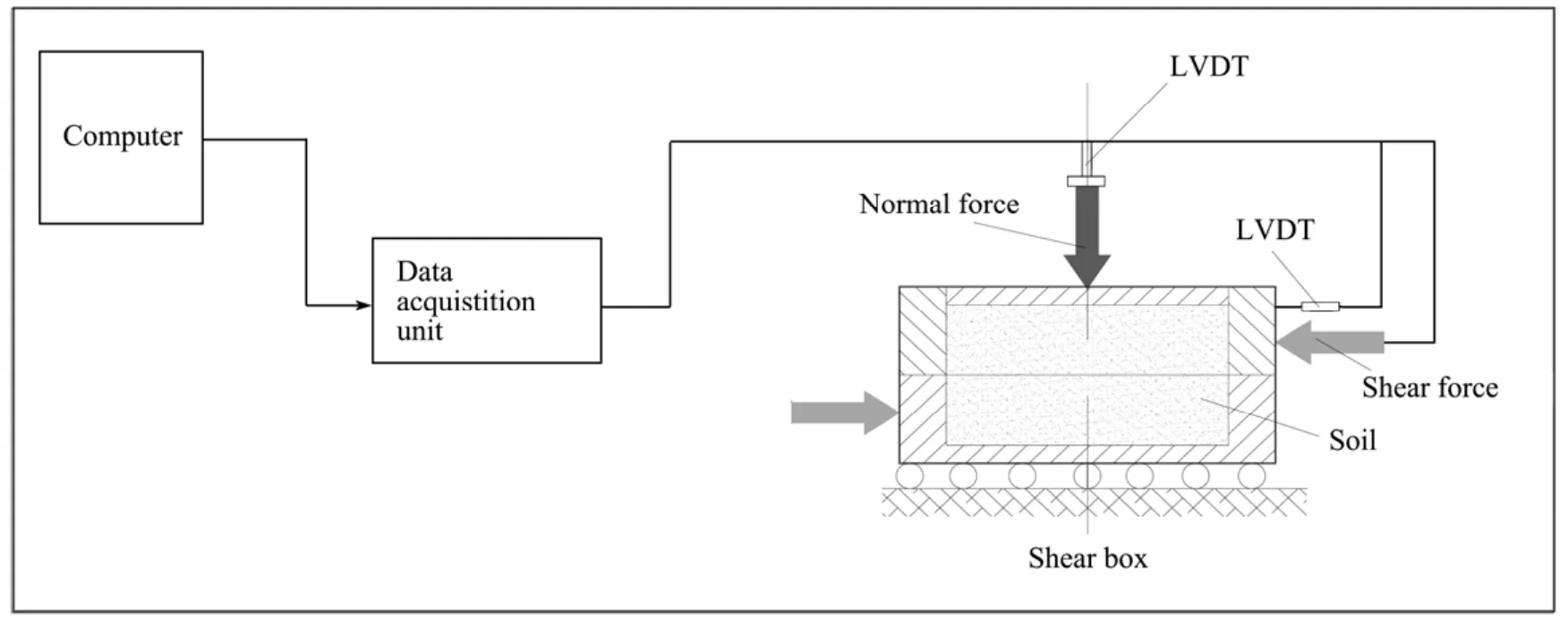
Figure 2 Computer-controlled experimental setup of the direct shear test
3 Experimental results
Our laboratory research showed that the anthropogenic frozen soils obtained by means of PVA-based CGF retained the properties of a solid body during thawing, even after one complete cycle of freezing-thawing. Furthermore, Lozinsky (2002)proved that the strength parameters of cryogels actually improve after several cycles of freezing-thawing. This demonstrates that the shear strength parameters of ice-soil composites do not degrade, which is important because the freeze-thaw cycle is a weathering process that frequently occurs in cold regions.
The shear test diagrams (Figures 3 and 4) representing shear stress versus strain at normal pressure (100 kPa) show that the ice-soil composites were stronger than the control soil samples at both negative (-20 °C) and positive (+20 °C) temperatures. It is very significant that the cryogel composites showed extraordinary plastic properties in both frozen and thawing conditions.Even with the general deformation of shear exceeding 10 mm and more, no cracks between the two halves of the samples were observed.
Our results also showed that the properties of soils obtained by means of CGF (in our case, cryogel with sand) were very different from the properties of the control soils, and that these properties can be regulated by means of different additives. The possible range of a few characteristics is shown in Table 1 (frozen condition) and Table 2 (post-thawing conditions). The data were obtained by performing several hundred different tests.
Considering the information contained in the tables, it is clear that the CGF method is very promising in solving the problems occurring in the freezing-thawing contact zones of hydro engineered and transport structures. The low deformation and density properties of cryogel composites after thawing present some technological difficulties in using the material, but it should be noted that at high pressure these properties transform to those of the sand used.
The technology of strengthening a frozen soil by means of the CGF method for the construction of water-retaining elements in weirs is protected by patents of the Russian Federation, No.1796650 and No. 2342484. The material presents a wide range of advantages, such as its good regulated characteristics including high plasticity, water tightness, ability to be used in both fresh water and sea water, and its being environmentally sound.

Figure 3 Shear stress (τ ) versus shear strain (ε ) of ice compared with ice-soil composite in frozen condition
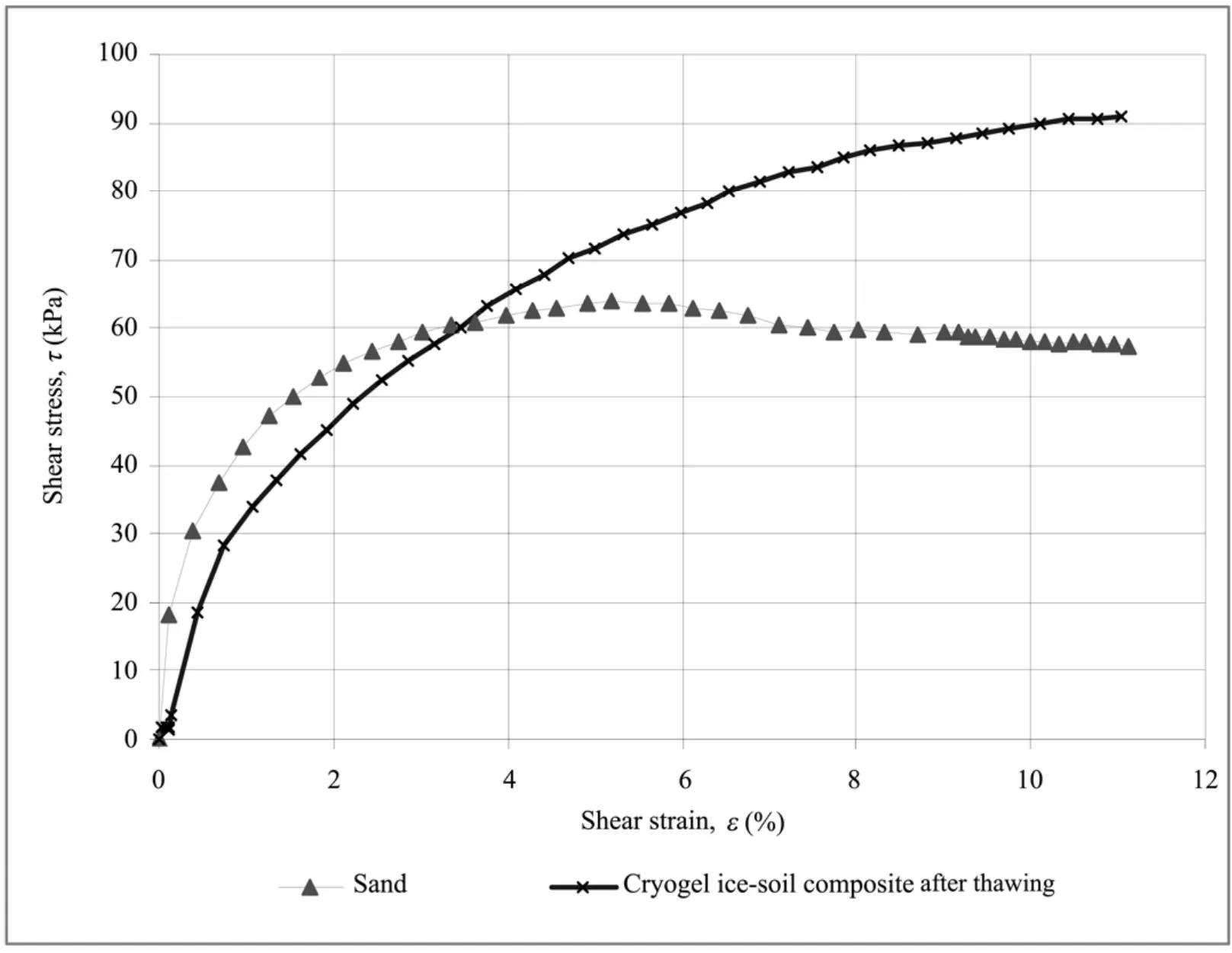
Figure 4 Shear stress (τ ) versus shear strain (ε ) of sand compared with cryogel soil composite in post-thawing conditions

Table 1 The properties of a cryogel ice-soil composite in comparison to ice in frozen condition at a negative temperature (-20 °C) (frozen condition)

Table 2 The properties of a cryogelice-soil composite after thawing in comparison with sand at a positive temperature (+20 °C) (post-thawing conditions)
4 Discussion
There are several specific problems related to constructing dams in cold regions. The first is that it is extremely difficult to construct conventional dam cores in winter. Another aspect of this problem is the availability of clay needed for a core, which should be in close proximity to the building site. If there is shortage of clay in the district, a cryogel composite diaphragm can be used instead of a clay core. This solution will certainly lengthen the period when it is possible to build because sub-zero temperatures accelerate the process of gel formation, which makes it easier to construct a cryogel diaphragm. It should be noted that positive temperatures will not stop gel formation but will only make it take longer.
The second problem is related to the sides of the clay core freezing to the banks (Figure 5, zone 2 and Figure 6, zone 4). If it is a thawed type of dam, this often leads to horizontal cracks appearing at the point of contact between the frozen and thawing parts of the core. The same may happen in a frozen type of dam if the freezing columns break down, which often happens in practice. This kind of crack is very dangerous and may lead to the dam being destroyed. This could be prevented by using a cryogel-soil composite for constructing a diaphragm in the upper part of the dam, as shown in Figure 6. This kind of diaphragm could also be used for effecting repairs. Also, the composite may be used in the area where the core touches the banks (Figure 7,zone 5) because, due to its plasticity, it will allow the core sides to settle and therefore lessen tension-related stresses in the core during the thawing process.
The third problem concerns dams constructed on a fissured rock foundation. Erosion of the clay core often occurs in the contact area between the core and the rock (Figure 5, zone 4 and Figure 7, zone 8). This necessitates widening the base of the core and, sometimes, construction of a concrete layer on the rock. Both measures are very expensive. Disregarding the problem presents even greater risk because repairs are extremely labor-intensive and costly. This could be prevented by using a cryogel composite as a thin layer at the foundation of the core, because its being watertight will prevent dangerous erosion (Figure 6, zone 6). This would also allow reducing the width of the core.
As for earthquake-related problems, it should be noted that the plastic properties of the proposed materials are so high that they permit at least a 20% strain without any cracks. This was proven by all of our strength tests, when the shapes of the samples were almost perfectly restored. Notwithstanding the lack of dynamic tests, the advantages of this material during dynamic loading are obvious.
The fact that freezing-thawing cycles improve the strength properties of cryogel composites makes the construction of water-retaining elements in winter even more advantageous. It is also known that during earthquakes the most dangerous zone is situated in the upper part of the dam. Considering the extraordinary plastic properties of the proposed CFG material, it would be fair to say that using a cryogel diaphragm will certainly improve the strength properties of matters in case of an earthquake strike.
We have shown just a few examples of using cryogel composites in dam building and repair work, but the range of possible applications may be far wider. One of the possibilities is using porous cryogel composites (Patent of the Russian Federation No. 1796650) produced with foam technology. This creates material with quite low thermal conductivity <0.3 W/(m·°C) as tested by the thermal needle probe procedure.
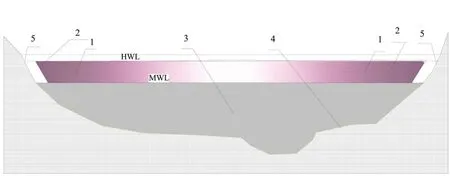
Figure 5 Longitudinal section of a dam of the thaw type on a fissured rock foundation in a cold region. 1: crack; 2: risk zone; 3: clay core of the dam;4: rock foundation; 5: zone where the core freezes to the banks; HWL: head water level; MWL: minimum water level

Figure 6 Cross section of a dam with a cryogel ice-soil diaphragm in the upper part of the core and cryogel erosion protection. 1: cryogel ice-soil diaphragm; 2: core; 3: transitional layer; 4: downstream pavement; 5: cryogel layer to prevent erosion; 6: cement screen; 7: rock fill
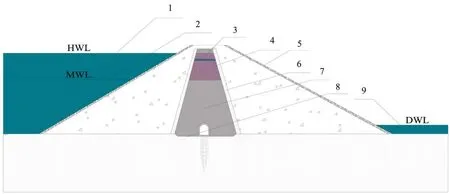
Figure 7 Cross section of a dam. 1: head water level; 2: minimum water level; 3: crack; 4: zone of risk; 5: downstream pavement; 6: transitional layer;7: core; 8: zone of possible erosion; 9: downstream water level
5 Conclusions
Our experimental data show that ice-soil composites obtained by cryotropic gel formation (CGF) are sufficiently strong and watertight for hydroengineered projects in cold regions, even during thawing. Three zones of possible applications in frozen and thawed types of dams are described: a CFG diaphragm in the upper part of the dam, and ice- and cryogel-soil composites in the contact areas between the banks and the foundation of the dam. There are certainly other possible applications of these composites in transport constructions, in both frozen and thawed conditions. The use of porous cryogel composites produced with foam technology in frozen constructions is also very promising.This method is quite new and needs further research. The laboratory stage is now fairly developed but it is necessary to perform a number of medium- and full-sized experiments to refine the technologies and to put such a promising material to good use.
Altunina LK, Kuvshinov VA, Dolgikh SN, 2006. Cryogels: Promising material for underground works in permafrost. In: Lombardi S, Altunina LK, Beaubien SE(eds.). Advances in Geological Storage of Carbon Dioxide. NATO Science Series IV, Earth and Environmental Sciences, Springer, 65: 103–110.
Eliseev AV, Cheverev VG, 2008. Method of erosion protection of the dispersed soil.Earth’s Cryosphere, XII(3): 36–40. (in Russian).
GOST 12248-2010. Soils. Laboratory methods for determining the strength and strain characteristics, 2010.
GOST 20522-96. Soils. Statistical treatment of the test results, 1996.
Lozinsky VI, 2002. Cryogels based on natural and synthetic polymers: Production, properties and domains of application. Uspekhi Khimii, 71: 559–585.(in Russian).
Pechovich AI, Razgovorova EL, 1979. Investigation of frozen soil compaction after putting them into water. Izvestiya of VNIIG Inc., 130: 92–99. (in Russian).
The B. E. Vedeneev All-Russia Research Institute of Hydraulic Engineering(VNIIG Inc.), 1992. Report of Develop a Technology of Year-round Building of Soil Structures for Low Head Hydroelectric Plants in Cold Regions. Project No. 10-10-040-3-7. St. Petersburg, Russia.
Vasiliev NK, Razgovorova EL, Shatalina IN, Ivanov YA, Kharitonov VN, 1993.Compound for an Artificial Ice, Patent of the Russian Federation. No. 1796650.23.02.1993. Bull. N 7. (in Russian).
Vasiliev NK, Sokurov VV, Ivanov AA, Shatalina IN, Razgovorova EL, 2008.Method of creation of a water-resistant screen in the soil materials of the elements of a hydrotechnical structure. Patent of the Russian Federation No.2342484. 27.12.2008. Bull. N 36. (in Russian).
Vasiliev NK, Ivanov AA, Sokurov VV, Shatalina IN, Vasilyev KN, 2012. Strength properties of ice-soil composites created by method of cryotropic gel formation.Cold Regions Science and Technology, 70: 94–97.
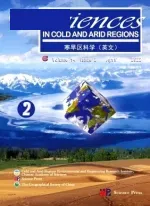 Sciences in Cold and Arid Regions2013年4期
Sciences in Cold and Arid Regions2013年4期
- Sciences in Cold and Arid Regions的其它文章
- Development of a dynamic load direct shear apparatus for the study of permafrost
- Roadbed, embankment, tower support and culvert stability problems on permafrost
- Field monitoring of railroad embankment vibration responses in seasonally frozen regions
- Different discretization method used in coupled water and heat transport mode for soil under freezing conditions
- Reinforcement effects of ground treatment with dynamic compaction replacement in cold and saline soil regions
- Review of the influence of freeze-thaw cycles on the physical and mechanical properties of soil
